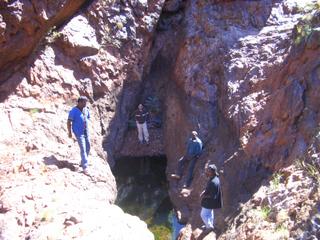Meeting Prince Charles at Newman

It can be difficult to retain the romance of regional
Like any other lawyer, land council lawyers need to obtain appropriate instructions from their clients. This necessitates group meetings with specific Aboriginal groups when matters of significance arise. Meetings can vary in size. Anywhere from 10 to over 700 individuals may be present!  Explaining complex ‘white fella’ law during these meetings can be challenging.
Explaining complex ‘white fella’ law during these meetings can be challenging.
The process of undertaking this explanation often reveals Aboriginal communities’ overwhelming sense of frustration with a system which, despite its complexity, unambiguously disenfranchises traditional owners from their land. We are talking here of people who, despite having been affiliated with very specific areas of land and water for several generations, have consistently been ignored. There are constant reminders of this. One of the mountains in the Pilbara is c alled
alled

At a meeting in the town of  to a mining project, even if they have been offered benefits in return for the mining. In practice, the tribunal that assesses objections has always found in favour of mining companies. This usually takes the form of a one-off payment or vague pronouncements to build a relationship with the communities upon whose land mining is proposed.
to a mining project, even if they have been offered benefits in return for the mining. In practice, the tribunal that assesses objections has always found in favour of mining companies. This usually takes the form of a one-off payment or vague pronouncements to build a relationship with the communities upon whose land mining is proposed.

To their credit, most mining companies now offer some level of benefits. A typical example of this is the promise to consider members of the community for employment opportunities. Despite this, the communities I’ve met have consistently complained that the mining companies should train their young adults, not just make theoretical job pronouncements they know cannot be met. More than anything, communities seek enduring relationships with big business and the government. The response from the government and big business is to consider situations on a case-by-case basis.
Earlier in the week I took part in a heritage survey with Freddie Milton*, one of the senior most elders in the region. Freddie is one of those iconoclastic old, wise men. With exaggerated pupils leaping out of his large spectacles, increasing his already earnest manner of speech, he explained, walking stick anchored surely into the ground, the significance of one or another ‘dreaming’ site. Remarkably fit for a man in his late 70s, he was not dissuaded from climbing rocky inclines or trudging through heavy bush growth if there was a site there. It is difficult to comprehend a sacred site. The significance is often all too subtle for untrained eyes to notice, but there is definitely something there. You just have to be patient and listen closely. The significance of these sites begins to emerge as much from its history as its physical characteristics.
* Not his real name.




4 Comments:
Comrade Iqbal,
Enjoyed the post, and am reading all the others, too. By the way, this week could be a good time to take a regional site-seeing tour http://www.abc.net.au/news/newsitems/200506/s1400831.htm.
Couscous, frozen in the capital
Frozen, not good!
I just heard a very patronising ABC local radio report on the union strikes up here. Words to the effect of 'the unions think the world will end whenever they go on strike.'
Thanks for your support Comrade. Any chance you might update your blog?
What's wrong with Lorem Ipsum?!?
I'll get around to it in a week. It'll be an archive of the blandness I get paid to produce.
Absolutem nothingus! Excellent, look forward to your next post.
Post a Comment
<< Home